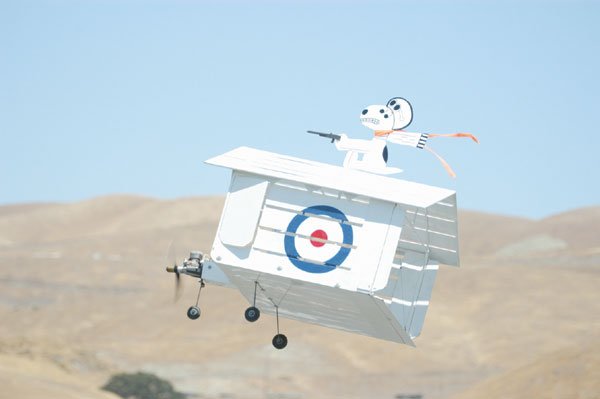Patrick Rose’s earliest memory was of flying a model airplane
with his father, a little U-plane that was tethered to its
”
remote
”
by a long cord and forced to fly in circles. For Rose, who was
just 3 years old at the time, the memory was magical. And ever
since he’s been in love with planes.
Patrick Rose’s earliest memory was of flying a model airplane with his father, a little U-plane that was tethered to its “remote” by a long cord and forced to fly in circles. For Rose, who was just 3 years old at the time, the memory was magical. And ever since he’s been in love with planes.
Of course, things have come a long way since Rose was growing up. Radio control devices for the planes have replaced the long, dizzying wires of the old U-planes with simple transmitters that allow enthusiasts to race and do tricks.
These days Rose, a 59-year-old retired engineer, is teaching himself to fly acrobatically. He’s crashed maybe a dozen miniatures, two of them in attempts to get a Lomcevac right. For those not in the know, that’s “a half snap to a full elevator that causes the plane to flip.” In other words, he rolls the plane and then drops it straight down before gravity causes it to go end over end.
“(The aerobatic planes) are built very light, so they’re not usually salvageable after a crash,” said Rose. “My first midair – where you’re coming straight at each other without realizing it and you’re both going about 60 miles per hour – the only thing I salvaged was the pilot figurine.”
The popularity of model aircraft flight reached its zenith in the 1980s, but the hobby remains widely practiced today, and Santa Clara County is one of the only spots in the South Valley area for amateur fliers. The Parks Department allowed the Santa Clara County Model Aircraft Skypark to build a runway in an idyllic spot between Monterey Rd. and U.S. 101 just north of Live Oak Blvd.
With three runways, a snack shack and picnic areas, it’s a weekend destination for many of the 400 members of the Thunderbirds, a club for model aircraft enthusiasts who pack snacks or whole lunches and come out either to fly or shoot the breeze – an activity also known as hanger flying.
“Saturday or Sunday with good weather you’re guaranteed to see someone,” said Mike Luvara, the club’s vice president. “You’ll have 50 to 100 pilots out during the course of the two days.”
Luvara spends a little bit less time out at the skypark now that he’s taking lessons toward his regular pilot’s license, but won’t give up model flying. It’s a family tradition.
Luvara’s dad, Rich, has been a model aircraft enthusiast since he was a teenager, but U-planes left him dizzy and, when radio controls came out in the 1970s, he found them to be beyond usefulness.
“The early transmitters were really too heavy and bulky,” said Rich. He didn’t actually get back into the sport until 1987, when the SCCMAS moved to its current location bringing his two sons, Mike and Chris, along to fly.
Pat Luvara, the matriarch of the Luvara family, came along to watch, but does not fly, preferring the role of team mom.
“It teaches kids a lot about not just science, but responsibility,” said Rich, a 62-year-old electrician. “They’re in charge of that airplane, from the time it takes off until they land it. It gives them that power in their hands.”
Their early experiences with model aircraft led the boys to center their lives on aviation. Chris, 23, is working toward his personal pilot’s license, and in the meantime he’s also working for his brother, Mike, at RCAT Systems.
Mike founded the company, which produces radio controlled devices that transmit real-time vital information – things like air speed, altitude and motor temperatures – from remote controlled planes and military drones to receivers on the ground.
The Luvara family may eat, sleep and breathe aeronautics, but Chris said once bitten by the hobby no one is immune.
Richard Groen’s curiosity was piqued as he drove past the field’s entrance each day on the way home from work.
“When I first showed up, a guy that didn’t even know me at all spent an hour with me showing me all about the planes,” said Groen. “If you’d come out and, during the day, something broke … if you needed a part they just gave it to you.”
The business manager, 39, has now been flying for three years, and says the people are what keep him coming back.
“You can get into this sport with a plane and all the equipment you need to get started for about $400,” said Groen. “Then they’ll train you here for free. You can fly all day for about five dollars in fuel, so it’s really a bargain once you’re done.”
Model aircraft come in all sorts of shapes and sizes with wingspans anywhere from 2 to 15 feet. The average plane has a 4- to 6-foot wingspan and weighs 5 to 6 pounds.
ARF these for real?
In the early days of model aircraft flight, enthusiasts could build their planes from kits, but that actually required cutting your own balsa wood, covering it and assembling the plane’s body as well as all of its electronic gear.
Fast-forward 20 years or so and welcome to the world of ARFs, the much debated new wave of model aviation. ARF stands for “almost ready to fly,” and is a kit plane whose sub-assemblies – wings, tail, body, etc. – are already completed.
Assembly time for an older kit could take well over 120 hours while an ARF can be put together in 10 to 20 hours.
Die-hards lament the passage of the sport from a band of dedicated builders and fliers to a group of ARF-fliers, but people who are new to the sport are able to get up in the air much more quickly and sometimes the interests in hand-builds and ARFs can be balanced.
Most giant-scale show planes are hand-builds, but for higher risk sport flying such as racing or aerobatics, ARFs offers owners the opportunity to not feel so bad about crashing them.













